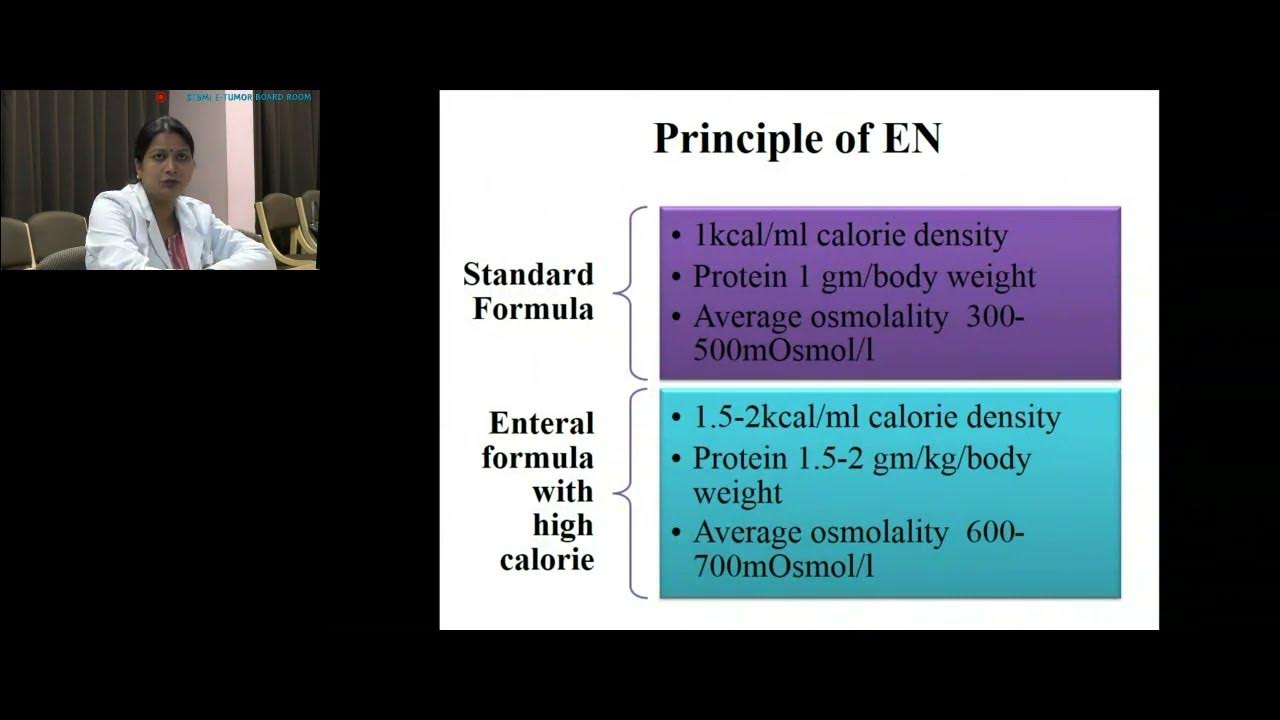Drug- Nutrient Interaction in Patient Receiving Enteral Nutrition
Summary
TLDRThe lecture discusses drug-nutrient interactions in patients receiving enteral nutrition, covering topics such as the definition and importance of enteral nutrition, factors influencing drug-nutrient interactions, and specific medications that require attention. Key areas include the characteristics and administration of enteral formulas, the role of protein content and vitamin K in interactions, and the impact of different medications like phenytoin, carbamazepine, fluoroquinolones, warfarin, theophylline, levothyroxine, and penicillin. Strategies to minimize interactions and ensure effective nutrition and medication management are also highlighted.
Takeaways
- 💊 Drug-nutrient interactions are critical in patients receiving enteral nutrition.
- 🍽️ Enteral nutrition involves delivering food or medication directly to the gastrointestinal tract.
- 🩺 Four factors influence drug-nutrient interactions: administration-related factors, drug-related factors, formula-related factors, and patient-related factors.
- 🧪 Administration factors include tube characteristics, the timing of formula and medication administration, and the location of formula delivery.
- 📏 Smaller and longer tubes increase the risk of blockage and affect the viscosity of medication.
- ⏳ Timing of administration is crucial; for example, delaying enteral formula for one hour before and after certain medications can minimize interactions.
- 🏥 Drug-related factors consider the dosage form and physical compatibility with enteral formulas.
- 🍖 Formula-related factors include protein content and vitamin K levels, which can affect drug efficacy, such as warfarin.
- 👩⚕️ Patient-related factors include protein status and GI tract motility, which can alter drug absorption and effectiveness.
- 📝 Specific medications like phenytoin, carbamazepine, fluoroquinolones, warfarin, theophylline, levothyroxine, and penicillin V require careful consideration and management to prevent adverse interactions.
Q & A
What is enteral nutrition?
-Enteral nutrition is the delivery of food or medication directly into the digestive tract, typically involving the esophagus, stomach, small intestine, and large intestine. It is used when a patient cannot, will not, or should not consume certain nutrients orally to prevent malnutrition.
What are the potential drug-nutrient interactions with enteral nutrition?
-Potential drug-nutrient interactions with enteral nutrition involve the components of the formula or the technique of administration, such as tube blockage, drug absorption issues, or insufficient nutrient intake.
What factors contribute to drug-nutrient interactions in enteral nutrition?
-Four factors contribute to drug-nutrient interactions in enteral nutrition: administration-related factors, drug-related factors, formula-related factors, and disease-related factors.
How does the length and diameter of a feeding tube affect its performance?
-Longer and narrower feeding tubes have a higher risk of blockage. It is important to consider the characteristics of the formula, the viscosity of the medication, and the tube's characteristics to avoid such issues.
What is the recommended timing for administering medication in relation to enteral nutrition?
-It is generally recommended to administer enteral formulas one hour before or after giving certain medications to minimize the risk of drug-nutrient interactions, particularly with drugs like phenytoin and warfarin.
Why is the site of enteral nutrition administration important?
-The site of enteral nutrition administration affects the physiological condition of the patient and the absorption of the medication. For example, medications intended for local effects in the stomach should not be given through tubes placed in the pylorus or jejunum.
What are the different forms of drug formulations and their significance?
-Drug formulations come in various forms like pills, capsules, suspensions, powders, and ointments. Each form affects the drug's pharmacological effect in the body differently, and some formulations may have coatings that protect them from stomach acid.
What are some methods to avoid physical interaction between drugs and enteral formulas?
-One effective method is preventing physical contact between the drug and the enteral formula. Other methods include diluting drug suspensions, using alternative drug formulations, or administering medications at different times than enteral feeds.
How does protein content in enteral formulas affect drug interactions?
-Enteral formulas containing different types of protein, such as intact protein or hydrolyzed protein, can affect drug interactions. Formulas with hydrolyzed proteins are generally more compatible with medications than those with intact proteins.
What specific medications require careful consideration when administered with enteral nutrition?
-Medications like phenytoin, carbamazepine, fluoroquinolones, warfarin, theophylline, levothyroxine, and penicillin V potassium require careful timing and administration to minimize drug-nutrient interactions.
Outlines

هذا القسم متوفر فقط للمشتركين. يرجى الترقية للوصول إلى هذه الميزة.
قم بالترقية الآنMindmap

هذا القسم متوفر فقط للمشتركين. يرجى الترقية للوصول إلى هذه الميزة.
قم بالترقية الآنKeywords

هذا القسم متوفر فقط للمشتركين. يرجى الترقية للوصول إلى هذه الميزة.
قم بالترقية الآنHighlights

هذا القسم متوفر فقط للمشتركين. يرجى الترقية للوصول إلى هذه الميزة.
قم بالترقية الآنTranscripts

هذا القسم متوفر فقط للمشتركين. يرجى الترقية للوصول إلى هذه الميزة.
قم بالترقية الآن5.0 / 5 (0 votes)






